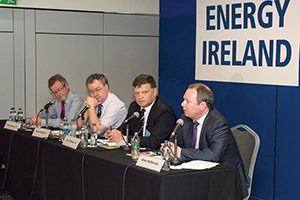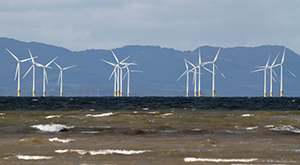
Political parties’ energy priorities
25th September 2015
Making the right choices
25th September 2015The future of renewable energy in Ireland

Professor Brian Ó Gallachóir of the Environmental Research Institute at University College Cork, evaluates how Ireland can reach its low carbon targets.
Ireland has an ambition to transition towards a low carbon economy by 2050, as articulated in the legislation on Climate Action and Low Carbon Development. There are a number of significant challenges in achieving this ambition for technology, for society and for policy. This article focuses on the role of technology in decarbonising Ireland’s energy (energy accounts for two thirds of Ireland’s greenhouse gas emissions) system, which in turn faces key questions such as the role of energy efficiency, the future contribution of renewable energy, the appropriate level of electrification (i.e. is the answer to decarbonise electricity and electrify everything?), the role of natural gas and the gas system (i.e. is a carbon neutral gas supply achievable by 2050). Among the key questions for renewable energy in particular that are addressed here are i) what share of our future energy use will come from renewable sources to meet our requirements for electricity, mobility and thermal comfort? and ii) what will be the contribution from individual renewable energy sources (i.e. from wind, biomass, solar, ocean, etc.)?
EU policy context
Ireland achieved a 7.8% share of energy use from renewable sources in 2013. We face a mandatory target to increase this to 16% by 2020 under the EU Renewable Energy Directive (2009/28/EC). Ireland’s 16%renewable energy target contributes to the overall EU target of 20% energy use from renewables by 2020. In November 2014, the European Council agreed an EU wide target for 2030 to achieve a 27% renewable share of energy use by 2030 but indicated that there would not be mandatory Member State renewable energy targets for 2030. There will however continue to be mandatory greenhouse gas (GHG) emissions reduction targets at Member State level for 2030.
The European Union set a 2030 target to achieve at least a 40% reduction in greenhouse gas (GHG) emissions relative to 1990 levels that in turn is decomposed into two individual emissions reductions targets that will each be underpinned by separate legislation. Companies that are involved in the EU Emissions Trading Scheme (ETS) will collectively face a 43% ETS emissions reduction target (relative to 2005 levels). Efficiency gains by large industry, electricity demand reductions and fuel switching in electricity generation (including renewable electricity generation) all contribute to meeting this target.
Sectors outside of the ETS face a collective target of 30% (non-ETS) GHG emissions reduction by 2030 (also relative to 2005 levels). These sectors comprise primarily of thermal energy use in buildings, transport energy use and agriculture. This 30% non-ETS emissions reduction target will be shared amongst Member States in a legally binding effort sharing agreement. It is not clear what the resulting mandatory target will be for Ireland. The EU target for 2020 is a 10% reduction in non-ETS emissions so the increase to 30% by 2030 is clearly ambitious.
Within the effort sharing agreement for 2020, Ireland currently faces a target of 20% non-ETS emissions reduction, which is proving very challenging. Energy efficiency achieved by improvements in building energy performance, improved emissions performance of vehicles and renewable energy use in transport and for heat all contribute to non-ETS emissions reduction.
Energy and climate mitigation modelling analysis at EU level using a least cost optimisation approach suggests that the 40% GHG emissions reduction target can be achieved at a marginal abatement cost (proxy for the necessary carbon tax level) of €40/tCO2 by 2030. The results of that analysis suggest the levels of ETS and non-ETS emissions reduction and these levels have now been adopted as targets. The same analysis also suggests that the optimal level of renewable energy is 27% and hence the European Council adopted this 27% target.
Regarding the longer term, the EU ambition is to transition to a low carbon economy by 2050, with a target to achieve GHG emissions reduction of 80% — 95% below 1990 levels. Ireland’s legislation on Climate Action and Low Carbon Development also sets out an ambition to transition to a low carbon economy by 2050. The role of agriculture is a distinctive feature of Ireland’s GHG emissions, accounting for 30% of GHG emissions, three times higher than agriculture’s share of EU GHG emissions. The challenges this poses are clear when we consider that an 80% reduction in CO2 emissions by 2050 results in just a 50% reduction in GHG emissions, in the absence of emissions reductions in agriculture.
Ireland’s low carbon roadmap to 2050
In order to support the development of legislation in Ireland for the transition to a low carbon economy, UCC and ESRI carried out technical analysis for a low carbon energy roadmap for Ireland. This roadmap is based on scenario analysis using the Irish TIMES energy systems model that has been built by UCC. The focus is on the role that technology can play in enabling Ireland’s transition to a low carbon economy at least cost. The analysis provides results for the period between now and 2050 but the focus here is on the resulting energy system configuration in 2050. It is worth noting that this analysis focuses on long term CO2 emissions across the energy system, i.e. not distinguishing between separate targets for ETS and non-ETS targets.
Figure 1 (shown on the right) shows the results from a Business as Usual (BaU) scenario which provides a useful benchmark against which to consider the low carbon scenario. This BaU scenario represents an energy system pathway that meets our future energy needs at least cost in the absence of emissions reduction targets. Energy end use here is 180TWh, representing nearly a 50% increase (1% per annum on average) compared with current levels by 2050. Renewable energy accounts for 10% of energy use, indicating low growth compared with current levels of 8%. Electricity represents 18% of energy use, similar to current levels.
Figure 2 (shown below) shows the results for a low carbon scenario, i.e. least cost energy system to meet future energy needs in Ireland at least cost and achieving CO2 emissions reduction of 80% below 1990 levels by 2050. This energy system is radically different from that shown in the BaU scenario. Energy end use here is 120TWh, indicating an efficiency gain of 33% relative to the BaU scenario. Although this represents a least cost solution, this does not mean it is inexpensive. The marginal abatement cost increases to over €450/tCO2 by 2050. This is a proxy for the level of carbon tax required to deliver the resulting changes to the energy system in the absence of other policies. Oil usage has been reduced apart from in international aviation (which is not considered here as part of the national emissions reduction ambition). Natural gas has a significant role in this low carbon energy system, which may at first appear counter intuitive. Most of the gas usage however is in electricity generation and this is in power plants that have carbon capture and storage (CCS) technology.
Renewable energy accounts for 55% of energy use, and this is dominated by biomass, comprising indigenous biogas being used in freight transport, solid biomass for heating in industry and liquid biofuels for freight transport. Renewable energy accounts for 63% of thermal energy, dominated by solid biomass but also some biogas for residential heating (via the gas network). Transport energy is very different compared with the BaU scenario, with the 2050 car fleet dominated by electric vehicles and liquid biofuels and biogas providing the bulk of the remaining energy needs (i.e. for freight, public transport, etc.). In addition to the electrification of the car fleet, there is also some electrification of residential heating, and in this scenario, electricity accounts for 29% of end use. This clearly suggests significant electrification but equally that most of the energy system is not electrified. The installed capacity of wind power grows to over 5GW and solar PV accounts for over 2GW by 2050. There is no contribution from offshore renewable electricity generation (i.e. offshore wind, wave or tidal energy) in this scenario.
Energy use by mode in 2050
Figure 3 shows the energy use by mode (i.e. for electricity, transport and heat) in 2050 in Ireland, highlighting the role of renewable energy. This helps to explain the constraining factors affecting renewable electricity and the need to focus on renewable transport and renewable heat. Firstly, the level of electrification, as mentioned, has grown such that electricity represents 29% of energy. This means that in these scenario results, the bulk of energy use (71%) is non-electrical energy used for transport and heat. Secondly, there are constraints on how much electrical energy can be provided by non-synchronous renewable electricity. In this scenario, renewable energy provides 51% of electricity. There remains significant uncertainty regarding the possibility of increasing this share from non-synchronous renewable electricity, given the island nature of Ireland’s synchronous power system.
What if CCS or bioenergy imports are unavailable?
The low carbon scenario presented thus far is open to challenge on a number of fronts. Certain technology options are not included, such as nuclear energy. In addition, there are many uncertainties, including thos
e regarding the projections of economic growth and demographics, the fuel price projections and the assumptions regarding future technology development and costs. Two particular uncertainties relate to the availability of carbon capture and storage technology and the future quantities of imported bioenergy that may be available. Additional scenario results are shown to take account of this uncertainty in Figure 4. The three scenarios all achieve an 80% reduction in CO2 emissions at least cost, i) CO2-80, i.e. 80% CO2 emissions reduction, as before; ii) No CCS, i.e. 80% CO2 emissions reduction but with no CCS allowed and iii) No BioImp, i.e. 80% CO2 emissions reduction but with no biomass imports allowed.

The No CCS scenario results show that in the absence of CCS technology, dependence on bioenergy increases further, as woody biomass is now also used for electricity generation. In this scenario, the share of renewable energy increases to 62% of total energy use and the renewable energy share of electricity reaches 77%. There is a small reduction in the level of electrification of residential heating but not many changes in energy end use, compared with CO2-80. The marginal abatement costs in this scenario reach more than €600/tCO2 in 2050.
The No BioImp scenario (that excludes imported biomass) is characterised by a significant increase in electricity generation provided by (relative to the CO2-80 scenario) a doubling of the natural gas CCS installed capacity (to 3.5GW), an increase in wind installed capacity (including 1.6GW of offshore wind) and an increase to 2.9GW in solar PV. This scenario sees an increase in electrification of residential heating and industrial thermal energy. Part of the electricity is also used to produce hydrogen which is used along with biogas to meet the demand for freight transport. The share of overall energy use by renewables is 42%. The marginal abatement costs in this scenario reach more than €700/tCO2 in 2050.

Conclusion
Renewable energy has a key role to play in Ireland’s transition to a low carbon economy. The analysis here points to an eight-fold increase in renewable energy by 2050 relative to current levels, with the share of renewables increasing from 8% to 52% of energy use. A three-fold increase in renewable electricity generation is envisaged but renewable energy will be dominated by non-electrical renewable energy in transport and heat, largely provided by a range of (solid liquid and gaseous) bioenergy sources.
Brian Ó Gallachóir is Professor of Energy Policy and Modelling in University College Cork, Chair of the Executive Committee for the International Energy Agency Technology Initiative on Energy Systems Modelling (IEA-ETSAP) and Vice-Chair of Energy Cork.



